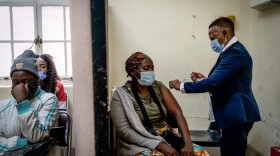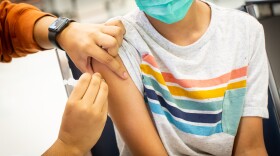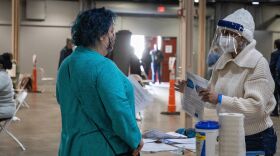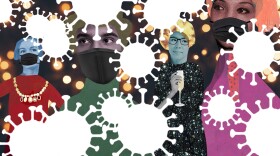How bad could an omicron surge get this winter?
Until key questions about the new coronavirus variant are answered, it's impossible to predict its impact with certainty. Still, several teams of scientists are using computer models to project possible scenarios for the Centers for Disease Control and Prevention.
Among the first omicron-related projections to be made public is one from the UT COVID-19 Modeling Consortium at the University of Texas at Austin. That group has modeled 16 omicron scenarios that cover a range of "how quickly it spreads, how easily it evades immunity and how quickly we're able to roll out booster shots," says Lauren Ancel Meyers, who directs the consortium.
According to some of those scenarios, the omicron wave might only intensify the delta surge that's underway. But in the most pessimistic scenario, omicron could trigger a tidal wave of infections that would be worse than last winter's massive surge.
By around the end of January, more than 500,000 people could catch the virus every day on average, which is more than double the peak reached last winter, according to the most pessimistic scenario.
In the following weeks, an estimated 29,812 people would be hospitalized with COVID-19 and 3,876 would die every day on average, according to this projection.
"The most pessimistic scenarios are scary. And we need to sort of equip ourselves to make changes — change policies, encourage more cautionary behavior — if and when we start to see hospitalizations tick up in this country," Meyers says.
But Meyers stresses that the most dire scenarios assume the very worst, including that the U.S. takes no additional measures or behavior changes to slow the spread of the virus, such as more masking and social distancing.
The pessimistic scenario also assumes that omicron is extremely adept at evading our immune systems and that omicron makes people sicker than delta does. Omicron is proving to be good at evading immunity and vaccines. But so far, evidence suggests it may cause milder illness, though that remains the biggest and probably most consequential open question.
The more optimistic projections are far less frightening. In the least pessimistic scenario, the omicron wave peaks around the middle of January and cases are only about double what they are now — reaching 189,069 on average every day. In this scenario, omicron would lead to only a few thousand more hospitalizations and a few hundred more deaths each day — 10,538 hospitalizations and 1,412 deaths on average.
In this hopeful scenario, "it's just sort of a little bump. It's not a catastrophic surge that overwhelms our hospitals and leads to record number of deaths," Meyers says.
But that scenario assumes that omicron isn't quite as good as it is in the pessimistic scenario at sneaking around our immune systems, that it doesn't make people any sicker than delta and, importantly, that more people get boosted.
The reality could fall somewhere between the best and worst scenarios, especially because the country's rate of people getting boosted is still low. In all scenarios, increasing the rate of Americans who get boosted decreased the projected numbers of cases, hospitalizations and deaths.
Even the less severe scenarios will put a strain on hospitals already struggling under a delta surge in many parts of the country.
"There is just nothing that can transmit this quickly, which is going to be kind to a society that has hospitals that are already full," says William Hanage, an associate professor of epidemiology at the Harvard T.H. Chan School of Public Health.
The bottom line is that the U.S. has to take omicron very seriously, say Meyers and other scientists studying its spread. Millions of people are still vulnerable to severe disease because they aren't vaccinated.
So it's important to start taking precautions now — "tap on the brakes" — Meyers says, to avoid having to "slam on the brakes" later.
"We need to prepare for the worst and hope for the best," says Alessandro Vespignani, a computational epidemiologist at Northeastern University who's also modeling possible impacts of omicron in the United States.
The omicron wave could be significant or could turn out to be a "casedemic," a big increase in infections but not in hospitalizations or deaths because the infections don't cause serious illness, he says.
"That would be a completely different story. We don't know yet," he says.
Others say the impact of omicron could vary significantly across the country. In places where the delta surge may have already peaked or is close to peaking, omicron could just "create a longer tail, meaning that it may result in a slower decline in the surge," says Dr. David Rubin, who runs the PolicyLab at Children's Hospital of Philadelphia.
But omicron could "aggravate the size or the magnitude of the peaks or duration of peaks in other areas that are still accelerating," he says.
Places like the West Coast could be vulnerable, along with Texas, some Southern areas like Nashville, Tenn., and Atlanta, coastal parts of South Carolina and "the entire mid-Atlantic through North Carolina," he says.
"If you're in an environment where gatherings are occurring and it's accelerating quickly and the temperatures are changing and people are moving indoors, you have all the forces moving in the right direction to actually escalate those peaks and transmission," Rubin says.
"What I'm saying is it really depends on where you are," Rubin says.
Copyright 2021 NPR. To see more, visit https://www.npr.org.














